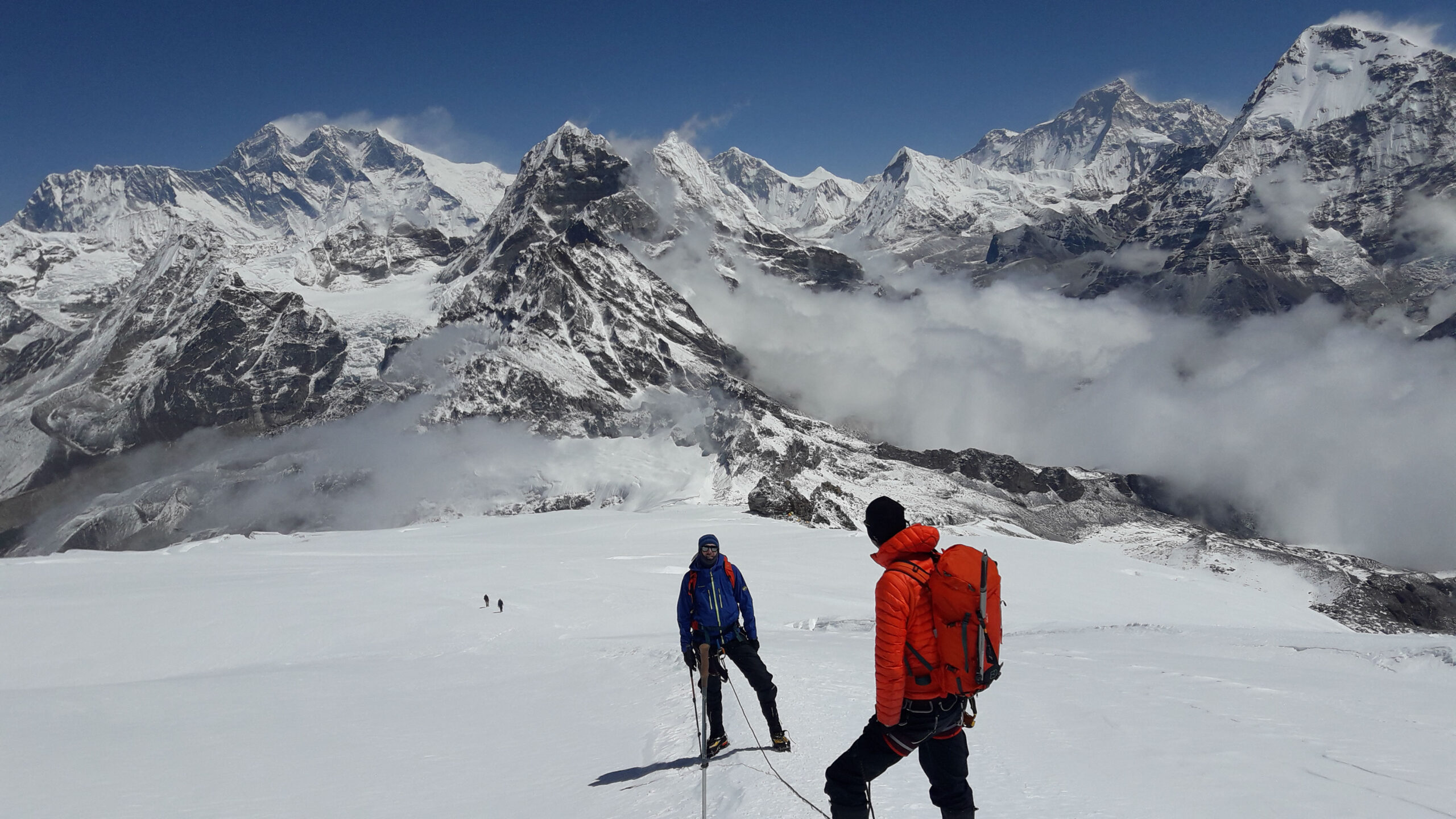In the Everest Himalayan region sits the spectacular mountain known as Mera Peak. At a height of 6,476 meters (21,247 feet) above sea level, it stands magnificently. Mera mountain is the highest trekking mountain in the Himalayas at this elevation. Mera height, located in the Mahalangur range of the Everest region, has sweeping views of more than 8,000 meters of height, including Cho Oyu, Kanchenjunga, Lhotse, and Everest.
Trekking and climb Mera Peak are both enjoyable in the spring. Vibrant hues of rhododendron and wildflowers cover spring paths. Enchanting vistas are produced by hill woods painted with vibrant hues. The season’s ideal weather makes it possible to see the stunning high-altitude peaks and the surrounding alpine landscape. Consistent snowfall contributes to the faster hiking speed and lower avalanche danger. The cooler temperatures of spring make for a pleasant hike across beautiful countryside. Trekking and climbing during the longer daylight hours provide ample time to acclimate and enjoy the breathtaking scenery at high altitudes.
A beautiful season with a captivating Himalayan vibe is spring. When birds and animals are more active, the natural beauty comes to life. Since spring is the most popular time of year for trekking, there is a lively vibe on the trail and in base camp. Similarly, hiking in the Makalu Barun National Park, which is home to a wide variety of species, offers a more in-depth look at the biodiversity of the area. The far-off views of massive Everest, Lhotse, and Makalu provide a captivating backdrop to the trekking adventure. For mountaineering enthusiasts, setting out on this breathtaking walk and climb combined expedition is a fulfilling experience.
There are connections between the trekking path to Mera Peak and the Sherpa communities of Ningsow, Kothe, and Khare. This is an excellent opportunity to engage with the community and become fully immersed in its culture. In addition, spring brings with it a number of holidays, including Chaitra Dashain, Nepali New Year, and Holi (the festival of colors). Participating in and celebrating these festivals with local communities might provide you with a rich experience.
Praiseworthy are the people’s simplicity, friendliness, and innocence. Experience the genuine warmth and generosity of the Sherpas by touring a few monasteries in the area. A springtime climb of Mera Peak combines breathtaking scenery, cultural experiences, and a variety of breathtaking topographies.
Mera Peak Climbing in Spring – Major Highlights
- The greatest option is to climb Mera Peak in the spring, when lovely trails with many blooms are accessible.
reaching the top trekking peak in a reasonable amount of time - Savor an adventure on a breathtaking mountain flight to Lukla.
- In the spring, Mera Peak displays the varied landscapes of the Everest region in addition to its abundant blooms.
- Traditional villages’ gracious hospitality and warm welcome
- Mountaineering talents are put to the test when climbing the over 6,000-foot peak.
- Impressive views of some of the highest mountains in the world, including Cho Oyu, Lhotse, and Everest
- Magnificent Himalayan vistas in a variety of Everest region settings
- See isolated communities and learn about the distinctive and complex Sherpa culture.
- Despite the high altitude ascent, it is suitable for both novice and experienced mountain climbers.
- diverse environments, ranging from high-altitude alpine meadows to rhododendron woods
- The visual experience was enhanced along the way by dramatic changes in the scenery.
- Trekking at high altitudes while traversing the Glacier Moraines
- traversing the breathtaking Hinku Valley and Zatrwa La Pass (4,610 meters/15,124 ft)
beautiful, more secluded location than the congested Base Camp Trail - Across the breathtaking Khari La Pass, which is 2,860 meters (9,383 feet) high
Outline itinerary
Day 1 : Arrival in Katmandu (1,300m/4,264ft) & transfer to hotel.
Day 2 : Trip preparation day at Kathmandu.
Day 3 : Fly to Lukla, trek to Paiya (Chutok) (2,730m/8,956ft) Duration: 5-6 hours.
Day 4 : Trek from Paiya to Pingkongma (2,846m/9,337ft) Duration: 5-6 hours.
Day 5 : Pangkonma to Ningsow (2,863m/9,393ft) Duration: 5-6 hours.
Day 6 : Ningsow to Chhatra Khola (3122 m /10,243 ft.) Duration: 7-8 hours.
Day 7 : Chhatra Khola to Kothe (3,691m/12,109ft) Duration: 6-7 hours.
Day 8 : Kothe to Thaknak (4,358m/14,297ft) Duration: 3-4 hours.
Day 9 : Thaknak to Khare (4900m) Duration: 2-3 hours.
Day 10 : Khare: acclimatization and pre-climb coaching.
Day 11 : Khare to Mera High Camp (5,780m/18,958ft) Duration: 6-7 hours.
Day 12 : Mera High Camp to Summit (6,461m/21,1907ft) and back to Khare (5045m/16,547ft) Duration: 8-9 hours.
Day 13 : Khare to Kothe (3600m/11808ft) Duration: 4-5 hours.
Day 14 : Kothe to Thuli Kharka (4,300 m/14,107ft) Duration: 5-6 hours.
Day 15 : Thuli Kharla to Lukla via Zatrwa La pass (4,600 m/15,091ft) 6-7 hours.
Day 16 : Fly back to Kathmandu (1,350m) Duration: 30 Minutes flight.
Day 17 : Transfer to The International Airport for your final Departure.
Trail Summary
The daring trek through the Himalayas begins, as usual, in Kathmandu. We take an exciting 30- to 35-minute flight to Lukla, the Everest entry point, early in the morning because our target is Mera Peak in the Everest region. This trip transports you from the crowded, busy streets of Kathmandu to a peaceful alpine area. After that, we’ll embark on a hike and make our way to Puyan, where we’ll spend the first night.
The paths of Pangum, Ningsow, and Chhetra Thanga are connected the next day, and on the seventh day, also referred to as (Mosom Kharka), they arrive at Kothe. In a similar vein, we hike to Mera La, a high mountain pass at 5,415 meters/17,766 feet, passing through several Everest Region communities, including Thangnak and Khare. Acclimating to the surroundings gradually is the goal of the climb up to Mera La. We will not be staying at the Mera La because of its great height; instead, we will spend a night at a base camp that is quite low in altitude.
Following a day of recovery in Base Camp, make sure you’ve properly acclimated before aiming for the 5,800-meter-high Mera Peak High Camp. There are tougher slopes on the trail ahead, including ice and snow climbs. After arriving at the high camp, we move steadily and gradually toward the peak. The easier parts are over as you go towards the top, and then the more technical parts appear. You can eventually reach the summit of Mera Peak using simple climbing equipment. After enjoying some celebrating time on the summit, begin your steady descent. From the foothills of Mera Peak, take the same path back to your starting point.
Distance and duration of Mera Peak Climbing
Depending on the exact route selected, there are differences in the hiking distance required to reach the summit Mera Peak. Usually, the trekking distance is completed to reach the base camp of Mera Peak. It typically takes 65 kilometers, or 40 miles, from Lukla, the starting site of the trek. The ascent is roughly 10 kilometers (6.2 miles) round trip from the base camp of Mera Peak to the summit. As a result, the total mileage of the walk and ascent will be approximately 75 kilometers/46.6 miles.
The amount of time you spend trekking depends on a number of variables, including the type of experience you hope to have while traveling, trail conditions, trekking pace, weather, and acclimatization stops. Trekking up and down the steep mountain slopes takes about ten to twelve days to finish. Trekking from Lukla to the Mera Peak Base Camp, multiple acclimatization stops, and exploration of the hilly terrain are all included in the time.
The ascent takes four to six days, during which time high camps are set up, an acclimatization cycle is undertaken, and Mera Peak summit pushing is done. One may go from the high camp to the top of Mera Peak in a single day with the right preparations and acclimatization. It would be better to stress a steady ascent for a fun and safe mountaineering experience. The combined trekking and climbing trip takes roughly 18 to 20 days to complete.
Mera peak climbing cost and permits
The length of the trekking and climbing adventure, the services provided during that time, and any extra services affect the cost of Mera Peak Climbing. Depending on the season, there are different permission fees to climb Mera Peak. The cost of the trekking package, which typically includes lodging, meals, guides, and transportation between Kathmandu and Lukla, can range from $1500 to $3000.
Similarly, the cost of the climbing package, which includes professional climbing guides, porters at high altitudes, and logistics, can range from $2000 to $5000 or more. The remaining charges include lodging while in Kathmandu, travel and rescue insurance premiums, and other personal costs for things like gear, beverages, snacks, and tips.
Permits needed for the Mera Peak Climbing area are as follows:
TIMS card
In order to ensure the welfare of trekkers, TIMS (Trekker’s Information Management System) permits are provided in the Himalayas. Unfortunate collisions may occur when traveling on high-altitude roads, but the TIMS card is able to pass through. A TIMS card is available for NPR 2,000.
Makalu Barun National Park Entry Permit
The Makalu Barun National Park in the eastern Himalayas provides a breathtaking backdrop for the Mera Peak trip. A permit is required to enter the Park because the trekking trail passes through this protected area. Each person must pay NPR 3,000 for an entry permit into Makalu Barun National Park.
Pasang Lhamu Khumbu Rural Municipality Permit
It need an additional authorization from the local municipality to trek in certain regions of the Khumbu region. You are able to move through the restricted region with this permit. Permit issued by Khumbu Pasang Lahmu Rural Municipality allowing trekking in all of Solukhumbu’s ward no. 5. It is a crucial permission to hike through the surrounding area and reach Mera Peak. The permission will set you back:
$20 per individual every week (during the first four weeks)
$25 per person each week (after four weeks)
Mera Peak climbing Permit
You must need a special permit in order to climb Mera Peak. Each season has a different permit price for Mera Peak Climbing, which is:
Spring: $250
Autumn: $125
Winter and summer: 70 dollars
Difficulty Level and Technical Sections of Mera Peak Climbing
Even though Mera Peak is rather high, the climb is quite simple. It is uncommon to deal with technical difficulties during the peak because it is seen as non-technical. There are, however, a few sections that climbers must navigate using mountaineering gear and fundamental climbing abilities. Fixed ropes are necessary for traversing crevasses and climbing steep slopes. Thus, when climbing a glacier, climbers need be trained in proper rope technique. You should be familiar with the crevasse rescue techniques in case of an accident. Similarly, the last ascent to the summit entails a section of ice climbing that calls for the use of ice axes, crampons, and other essential gear.
Despite being almost 6,000 meters high, Mera Peak Expedition is a relatively straightforward mountain to summit. It helps to have some basic knowledge and abilities for trekking and climbing at high altitudes. It is essential to set up high-altitude camps prior to summiting the Peak. Before the summit push, a high camp typically situated above 5800 meters/19029 feet is established for acclimatization and preparedness. Therefore, for a climb to be effective and go well, a reasonable level of strength and physical fitness is needed.
For climbers aiming to reach over 8000 meters on summits like Everest, Kanchenjunga, Lhotse, Makalu, Cho Oyu, Dhaulagiri, Manaslu, and Annapurna, Mera Peak is an excellent training ground. The preparation ascent of Mera Peak provides experience that enhances confidence and skill sets for higher-altitude treks to more difficult peaks in the Everest region. Climbing Mera Peak is suitable for explorers of all skill levels; it is demanding but doable and satisfying.
Altitude Sickness in Mera Peak Climbing
There is no recovery from altitude sickness, not even at Mera Peak. The likelihood of altitude sickness developing increases when ascending above 2,500 meters. The elevation of the Mera Peak trip and climb route, however, varies greatly; it starts at about 2,860 meters (9,383 feet) and rises to 6,476 meters (21,247 feet) at the summit of Mera Peak. As such, Mera Peak experiences the same amount of altitude sickness as other Himalayan high peaks.
Temperature and Weather for Mera Peak Climbing in Spring
The trail gradually gains altitude as it passes through a number of acclimatization stations and arrives at base camp (5300 meters/17388 feet), high camp (5800 meters/19029 feet), and the summit. As such, there is a substantial risk of altitude sickness when climbing Mera Peak. But if enough fluids and acclimatization are followed, the risk can be reduced. It’s critical to maintain health consciousness by paying attention to your body. Wait to ascend until you are completely ready for the ascent. Return to lower altitudes if the altitude sickness worsens, and stay there until you feel well enough to continue.
Altitude causes a drop in temperature. It becomes colder as you ascend higher in altitude. But springtime brings nice, gentler weather in contrast to summer and winter. In the Himalayas, summer can be extremely hot and summers are excessively frigid. Aside from extremes of heat and cold, the mild springtime temps make for peaceful and enjoyable afternoon hiking.
Spring Weather Conditions in the Himalayas
Lower altitudes, less than 3,000 meters/9,842 feet, have daytime temperatures between 10 and 20 degrees Celsius and nighttime lows of 0 to 10 degrees Celsius. Similarly, springtime daytime temperatures in higher altitudes (over 3,000 meters) vary from 5 to 15 degrees Celsius. At high altitudes, the nighttime low is typically between -5 and -0 degrees Celsius. This represents the mean temperature for the three spring months of March, April, and May combined. For hiking and climbing the Mera Peak, the best weather is from late March to early May.
Between the previous summer and the upcoming winter, what can you anticipate? It’s a gorgeous springtime. The charming springtime weather is just as pleasant as it is. The beautiful skies and steady spring weather make for the best mountain visibility. The frozen winter’s traces gradually become distinct and dry. Less precipitation means that the trekking trip can be completed without incident. In a similar vein, this season sees less intense snowstorms and heavy rainfall, as well as a decreased chance of avalanches.
Since weather and temperature stability are not guaranteed in high altitude regions, it is important to prepare for changes in the local atmosphere when hiking in these areas. In order to stay comfortable, pack warm clothing, and be informed about the weather so that you may adjust your climb and trek schedule accordingly. Place a strong emphasis on setting out early in order to prevent arriving at the destination too late. Trekking during the day is pleasant and enjoyable if you start early. On time arrival at the site enables careful study of the surroundings and appropriate acclimatization. On the other hand, an early summit keeps the summit effort unhindered and avoids any potential afternoon winds.
Food and Accommodation
During the springtime Mera Peak Climbing, comfortable accommodations and good meals are provided. In the teahouses, basic lodging with two or three beds in a communal room is common. Because spring is a popular trekking season in the Himalayas, teahouses and lodges along the trail are in high demand. It is therefore wise to reserve lodging in advance to guarantee a place.
An entertaining evening consists of a lively ambience and large groups of hikers. A peaceful teahouse atmosphere is created by conversing, eating in a shared area, and engaging with other hikers. The availability of services is restricted when trekking in distant areas. You will use standard, public restrooms that are devoid of enough toiletries. Thus, remember to bring the necessities for personal hygiene.
In a similar vein, teahouse fare consists of all meals, drinks, and snacks. The teahouse serves a broad range of regional and international cuisine, including customized meals based on your dietary requirements. In teahouses, you can find tea, coffee, fruit juice, hot chocolate, and a variety of other drinks in addition to food such as dal bhat, momo, pizza, steak, thukpa, spring rolls, papad, spaghetti, boiled eggs, etc.
An even more wild and daring experience can be had while camping in the base and high-altitude camps during the Mera Peak climbing expedition. We’ll enjoy relaxing evenings in the open areas of base and high camps while tent camping. Regarding camping, we may supply you with equipment, or you can purchase or rent a tent. You will also have an adequate quantity of food for the duration of the hike.
What should I pack?
The packing essentials for Mera Peak Trekking and climbing lists are both available for springtime climbing. Make a note to bring only the essential equipment for the high-altitude excursion. You can carry the necessary clothing based on the springtime temperature and weather. In general, spring brings pleasant weather with consistent temperatures. The high-altitude atmosphere, however, can surprise you. Pack accordingly taking into account the strong Himalayan atmosphere.
To be warm and prevent getting wet in the event of rain, bring along cozy hiking shirts and pants, several pairs of woolen gloves for the alpine areas, fleece, rain, and down coats. The same goes for thermal tops for extra warmth, adjustable hiking pants, shocks, a scarf to block strong winds or snow, and a sun bonnet or brimmed hat to shield from encroaching sunshine.
Packing Essentials for the Himalayan Trek
Pack a sleeping bag, hiking poles, trekking boots, headlamp, sunglasses, and hot water bottles as far as gear and equipment goes. Keep some functional electronics with you, such as a power bank, chargers, cameras, and smartphones. Take special care with your personal hygiene and amenities since the walk passes through isolated Himalayan areas with little services. Bring tissues, hand sanitizer, lip balms, sunscreen, sanitary pads, nail clippers, toothbrushes, toothpaste, shower gel, and quick-drying towels, among other necessities.
Remember to pack a basic first aid kit for any accidents or injuries you may sustain while traveling. Aspirin, painkillers, antiseptic cream, and other supplies should be packed for immediate relief from wounds. Lastly, remember to bring the necessary paperwork, including ATM cards, insurance documentation, and permits. You can bring pens, books, notebooks, playing cards, video games, and other items for additional experience, depending on your unique interests. Having said that, make sure your backpack is always pleasant to carry and manageable in terms of weight when traveling uphill.
These packing lists are readily available in Kathmandu and may be conveniently packed in the included duffel bag. Furthermore, there will be down jackets and sleeping bags available, both of which must be returned at the end of the trip. Make sure you have enough cash in Nepalese NPR. You can withdraw cash from ATMs in Kathmandu or throughout the trek’s lower reaches.
Tips for Mera Peak Climbing in Spring
Set off early in the morning to hike in order to beat traffic and arrive at your destination on schedule.
Make sure you stay properly hydrated and get enough rest over the entire trekking trip.
Prior to initiating a climbing excursion, concentrate on strength-building training and exercises.
Stow the required clothing and equipment in a manageable amount, bringing only what you’ll need for the trip.
It is advised to reserve lodging in advance because it will probably grow busy.
Make sure you have all the equipment needed for climbing and trekking.
Before starting your daily trip, be informed on the latest weather forecasts.
To ensure your health and the purity of the water, always carry tablets for water filtration.
It is best to hire knowledgeable porters and guides only once you have a firm grasp of the profile.
Carrying power banks and solar chargers will be a more cost-effective solution.







